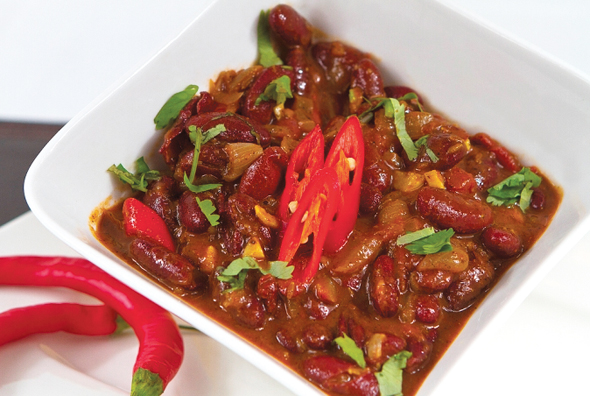Mama’s Punjabi Recipes: Rajma Di Turri (Red Kidney Bean Curry)
One of the great comfort foods for many Punjabis is a steaming plate of rajma (red kidney beans) and chawal (rice), served with a little bit of dahin (yogurt) and garnished with some achaar (pickle). Though there are other beans that are served with rice, like chole (chickpeas) and lobia (black-eyed peas), the flavor that rajma brings out is much different.
Kidney beans come in several types: the red ones are the most common and popular; but there are the light speckled kind, the red speckled kind and the white ones. The red kidney beans are used in cuisines in many countries: in Texas, the South and Mexico they are used in chili or chili con carne; in Louisiana it is served in the Creole dish of red beans and rice; in Cuba and other parts of Latin America, it is made into a dish called mole.
Part of the reason for the popularity of red kidney beans is that not only are they a good source of energy and cholesterol-lowering fiber, they are high in many minerals including potassium and folate (B9) which are good for the nerves, to produce healthy red blood cells and prevent anemia. They have a low impact on blood sugar levels which makes them ideal for people with diabetes, insulin resistance or hypoglycemia and can help prevent heart disease. They are a great source of protein for vegetarians.
It is important to soak the red kidney beans and then boil them for at least 30 minutes at 100 degrees to kill the lectin toxin that is found in the raw beans. The secret to the great taste of rajma is the texture that they take on when cooked with masala and the flavor that they give to the curry when left to simmer after the dish is ready.
Ingredients :
500gm rajma (red kidney beans)
1 large piyaaz (onion) – peeled and chopped
1 medium clump of adrak (ginger root) peeled and chopped
1 medium kernel of lasan (garlic) peeled and chopped
1 tablespoon of vegetable or olive oil
Tomato paste to taste
5 cups of pani (water)
Spices (to taste): namak (salt), mirch (red pepper), garam masala, hing (asafetida – optional)
Garnishes (to taste): dhania (coriander) chopped leaves
Directions:
1. Wash the rajma well, then pour into a pot and let them soak overnight in warm water. In the morning, pour the rajma through a strainer and throw away the water.
2. Bring a half-full pot of water to a boil, then pour in the rajma into the water, add salt and ginger and let them boil for 30 minutes.
3. Pour the rajma through a strainer and save the water to make the curry.
4. Peel and finely chop the onions and garlic. Throw them in a saucepan and brown them in the oil.
5. Add half a tablespoon of tomato paste, to enhance the taste, texture and add red color and mirchi and stir in. Those who prefer can add hing (astafetida) which helps in digestion, but the smell may be too strong for some.
6. Throw in the boiled rajma and then mix well with the masala over medium heat for 5 minutes to roast them and let the masala seep in, making sure that the rajma do not stick or burn.
7. Now pour in ¾ of the saved water and bring the rajma to a boil. The curry should be thick, but be careful that the rajma do not get mashed while cooking. Save the rest of the water in case you need to add more. Do not use cold water to the curry.
8. Turn the heat to low for 5 minutes to let the curry soak into the rajma. When it has cooled down a little, add the garam masala and dhania and mix well.
9. Turn the heat off, cover the pot and let it sit for 5 minutes. Eat with chawal but the rajma turri is just as good with roti or naan.
MAMA’S TIP OF THE WEEK
KEEP BEANS AND DAALS FROM GETTING MASHED WHILE COOKING
Very often, you come across a dish of daals, chole or bean curry which is mashed or so overcooked that they have become like a thick soup. Punjabis will joke and grumble that this is a dish you just can’t eat with a roti or naan, instead it has to be poured over a scoop of rice to be tasted. The correct way to serve daals, chole or beans is when you can see and taste the individual kernels and savor the flavor.
To make sure that these dishes stay plump and easily recognizable, it is important not to overcook them in a pressure cooker or boiling water so that the kernels do not become very soft and mushy. The other thing to remember is not to use cold water when making the curry: only add warm water so that the cooking time is reduced.
Shakuntla Malhotra is a skilled cook of Punjabi dishes made in the old-fashioned style that she learnt as a young woman in her ancestral home in Lyallpur, India before it became part of Pakistan after the Partition in 1947. People have often admired her cooking for its simplicity and taste that comes with each mouthful. Even in her mid-eighties, she continues to cook daily and agreed to share some of her delectable Punjabi recipes.


